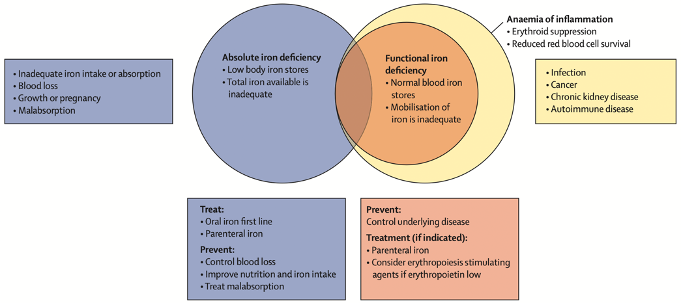Your basket is currently empty!
Iron deficiency as leading cause of diseases
Iron deficiency is one of the leading causes of the global burden of disease, particularly affecting children, premenopausal women, and people in low- and middle-income countries. Iron deficiency as leading cause of diseases such as Anemia, with clinical and functional impairments that can occur in the absence of anemia (as shown in the figure below).

The World Health Organization has recognized iron deficiency anaemia (IDA) as the most common nutritional deficiency in the world, with 30% of the population affected by this condition. Although the most common causes of IDA are gastrointestinal bleeding and menstruation in women, reduced dietary iron and reduced iron absorption are also culpable causes.
The clinical management of patients with IDA requires a comprehensive understanding of the many etiologies that may contribute to iron deficiency, including pregnancy, blood loss, congestive cardiac failure, renal disease, heavy menstrual bleeding, inflammatory bowel disease, bariatric surgery, or extremely rare genetic disorders.
Patients with IDA should receive treatment with the aim of replenishing iron stores and returning the hemoglobin to a normal level. This has been shown to improve quality of life, morbidity, the prognosis of chronic diseases, and pregnancy outcomes. Iron-deficiency anemia is the most common and treatable of all anaemias.
Iron deficiency can cause symptoms independent of anemia and can be associated with a variety of diseases. The most effective test to diagnose iron deficiency is serum ferritin. Iron supplementation can be administered orally, which is the first line of treatment in most cases, or intravenously for patients for whom oral iron is not effective or contraindicated.
Pasricha, S. R., Tye-Din, J., Muckenthaler, M. U., & Swinkels, D. W. (2021). Iron deficiency. The Lancet, 397(10270), 233-248. [Link]
Kumar, A., Sharma, E., Marley, A., Samaan, M. A., & Brookes, M. J. (2022). Iron deficiency anaemia: pathophysiology, assessment, practical management. BMJ open gastroenterology, 9(1), e000759.
DeLoughery T. G. (2017). Iron Deficiency Anemia. The Medical clinics of North America, 101(2), 319–332.
by
Tags:
